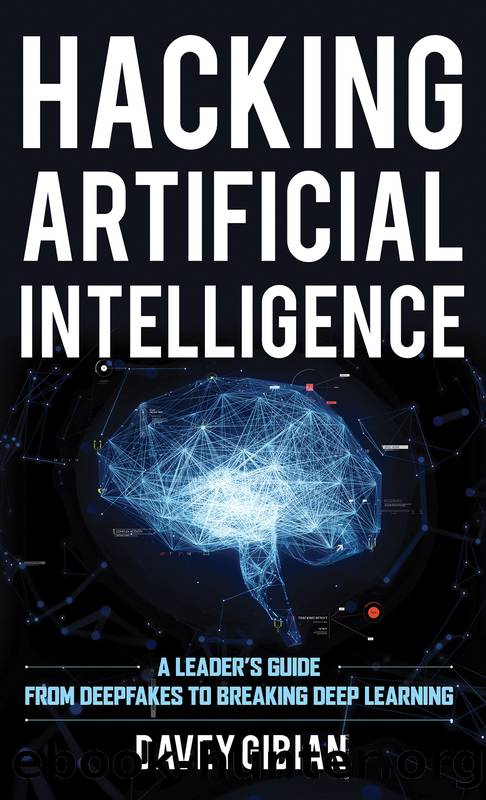Hacking Artificial Intelligence by Davey Gibian;

Author:Davey Gibian;
Language: eng
Format: epub
Publisher: Rowman & Littlefield Publishing
Published: 2022-03-29T00:00:00+00:00
STEALING DATA
To understand how underlying data can be stolen, it is important to understand how an AI learns. Recall that an AI learns first on a set of training data. Once trained, an AI can then be applied to real-world data to which it had not been exposed before. Exposing the AI to data beyond the dataset, known as the AIâs generalized learning, is critical. It is what allows an AI to be taken out of a training environment and exposed to real-world problems. If it was only able to operate under known, set conditions then it would resemble the rules-based classical AI school of thought, abandoned in favor of machine learning.
However, in a concept that borders on science fiction, AIs have memories. The entire notion of machine learning is based on the concept of these AI memories, and they are part of what makes choosing the correct training data so important. During training time, AIs learn patterns in the training data that are then applied elsewhere. Because AIs can then be taken and run on new data, AIs inherently ârememberâ the data they were trained on and make predictions based on this information. By interacting with an AI repeatedly, patterns can emerge that make it possible to reverse engineer the training data. These data privacy attacks weaponize these memories of an AI and make it possible to steal proprietary, underlying information that was used to train it.
One common approach to understanding the underlying training data of an AI is to test if a piece of data was in the original training set. This can be done even in situations where an adversary has no access to the AI other than the endpoint, similar to a BlackBox evasion attack. In one example, AI research teams used a technique known as a membership inference attack to recognize the differences in the AIâs predictions on inputs that were originally in the training set versus those that were not. This is a relatively straightforward example. The model simply made better predictions on data that was in its original training set. What is impressive about this simple technique is that it has been proven to be effective even against commercial âmachine learning as a serviceâ providers such as Google and Amazon.1
A real-world example of the damage a membership inference attack can have includes leaking personal information from a hospital. Using the same technique used against the Google and Amazon classifiers, AI security researchers were able to successfully test if certain persons were included in an AI system trained on hospital records.2 This could be used to see if certain patients had a certain health condition, such as a sexually transmitted disease, that they would prefer not be public knowledge, while also putting the company running the AI potentially in breach of HIPPA compliance.
In another potential compliance breach using membership inference attacks, teams have been able to determine if a userâs text message3 and location data4 was used to train an AI. Using this method,
Download
This site does not store any files on its server. We only index and link to content provided by other sites. Please contact the content providers to delete copyright contents if any and email us, we'll remove relevant links or contents immediately.
| Cryptography | Encryption |
| Hacking | Network Security |
| Privacy & Online Safety | Security Certifications |
| Viruses |
Effective Threat Investigation for SOC Analysts by Yahia Mostafa;(7345)
Practical Memory Forensics by Svetlana Ostrovskaya & Oleg Skulkin(7045)
Machine Learning Security Principles by John Paul Mueller(7025)
Attacking and Exploiting Modern Web Applications by Simone Onofri & Donato Onofri(6689)
Operationalizing Threat Intelligence by Kyle Wilhoit & Joseph Opacki(6667)
Solidity Programming Essentials by Ritesh Modi(4490)
Microsoft 365 Security, Compliance, and Identity Administration by Peter Rising(4087)
Operationalizing Threat Intelligence by Joseph Opacki Kyle Wilhoit(3833)
Learn Computer Forensics - Second Edition by William Oettinger(3579)
Building a Next-Gen SOC with IBM QRadar: Accelerate your security operations and detect cyber threats effectively by Ashish M Kothekar(3529)
Future Crimes by Marc Goodman(3511)
Blockchain Basics by Daniel Drescher(3485)
Mastering Azure Security by Mustafa Toroman and Tom Janetscheck(3463)
Mastering Python for Networking and Security by José Manuel Ortega(3445)
Incident Response with Threat Intelligence by Roberto Martínez(3310)
The Code Book by Simon Singh(3064)
Mastering Bitcoin: Programming the Open Blockchain by Andreas M. Antonopoulos(2975)
Mobile App Reverse Engineering by Abhinav Mishra(2951)
From CIA to APT: An Introduction to Cyber Security by Edward G. Amoroso & Matthew E. Amoroso(2850)
